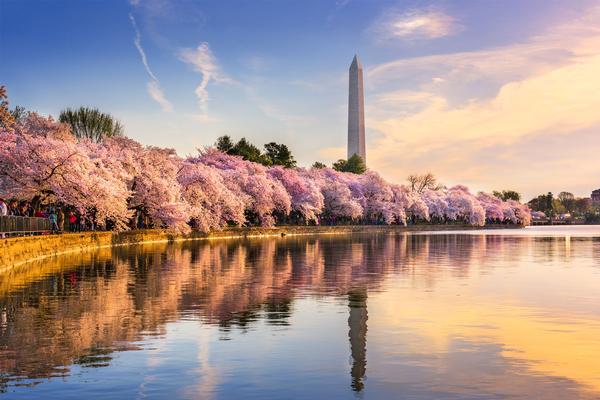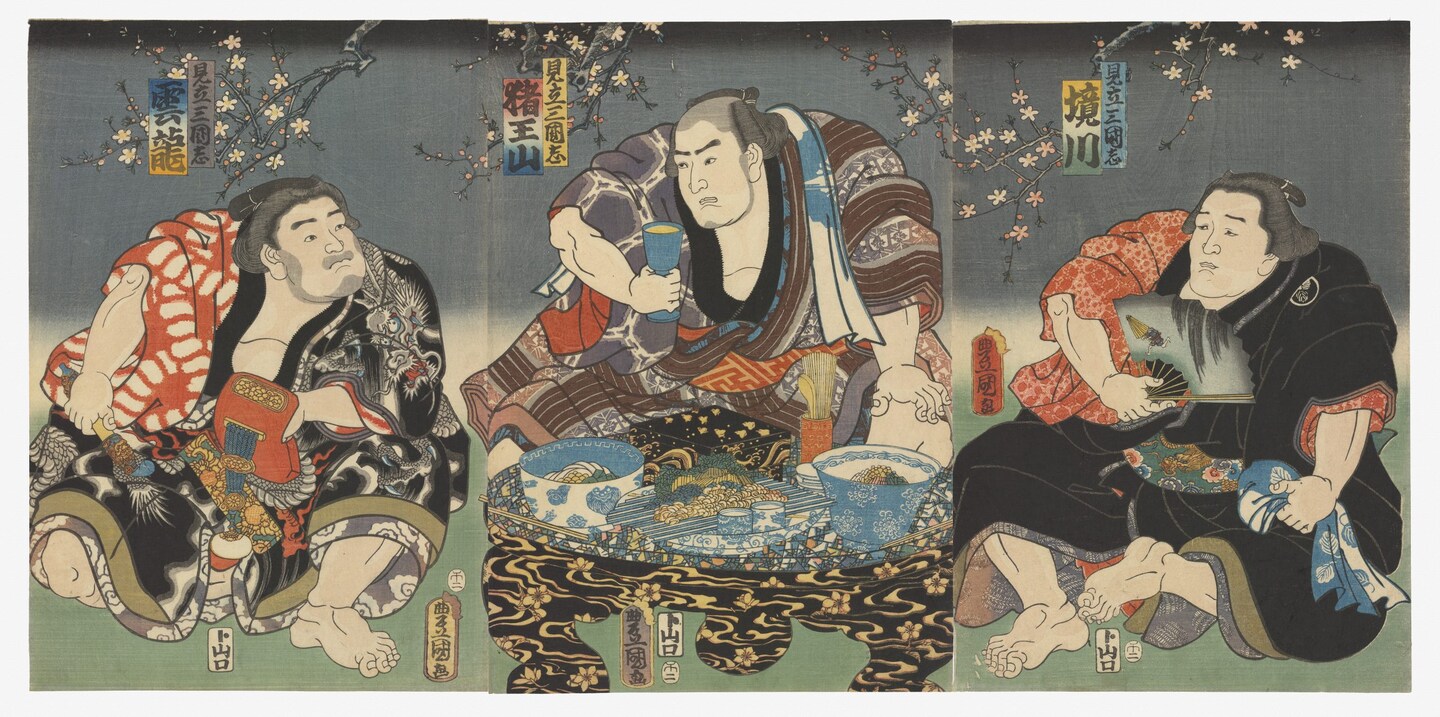On view as part of the exhibition “Underdogs and Antiheroes: Japanese Prints from the Moskowitz Collection,” which opens March 19, the work is one of several in the museum’s collection that emphasize not just sakura, or cherry blossoms, but related activities: coming together in celebration of spring. The Japanese tradition of flower viewing, known as hanami, can take many forms. Here are some other artful ways to celebrate the spring season.
In April 2020, Munich-based digital artist Tamiko Thiel found herself isolated in her apartment, longing for the cherry trees that brought joy to her childhood in Japan. Spring was in the air, but so was infection, so Thiel — an engineer, computer artist and one of the key designers of the first supercomputer — turned to technology to bring the blossoms to her fingertips. The result, an augmented-reality, app-based artwork, “Suspended Spring,” uses your smartphone camera to create the illusion that you’re surrounded by fluttering pink petals. Starting March 20, the artwork will be available across the DMV through a mobile app. Thiel hopes it will prompt reflection, noting that cherry blossoms once represented young samurai warriors who were killed in battle. “In Japanese culture the cherry blossom symbolizes the ephemeral beauty of life itself” Thiel said, via email. “The cherry blossom asks us to open our senses and focus intensely on the beauty of the moment.” “Suspended Spring” is a part of “ReWildAR,” a project commissioned for the Smithsonian’s “Futures” exhibition, on view through July 6 in the Arts and Industries Building, 900 Jefferson Dr. SW. aib.si.edu. “Suspended Spring” will be available within a geofence surrounding the D.C., Maryland and Virginia region on the app ARpoise, available for iOS and Android. It will be available through April 17.
You might think social media is a 21st-century phenomenon. But in Edo-period Japan (1603-1867), some woodblock prints circulated so widely, you might say they went viral. Long before Instagram, such popular print series as Utagawa Hiroshige’s “The Fifty-Three Stations of the Tokaido” — which documents his journey along a famous road in Japan — inspired ordinary viewers with wanderlust. And vivid ukiyo-e (or “floating world”) prints provided new ways of seeing everyday life — Kabuki theater, sumo wrestling, pleasure districts — akin to social media posts. Highlighting this connection, the exhibition “Exploring Hiroshige and His Influence on Social Media” features contemporary photography that reflects Hiroshige’s style, paired with work by the printmaker from American University’s collection. March 22 through May 13 at the Japan Information and Culture Center, 1150 18th St. NW, Suite 100. 202-238-6900. us.emb-japan.go.jp/jicc/. Free.
If seeing cherry blossoms with your own eyes isn’t enough, you may want to experience them in the highest pixel resolution ever, as Artechouse promises in its promotional material for “Pixelbloom.” The fifth annual cherry blossom show at the tech-centric art space will take viewers on a journey through digital flowers with a 22-minute, 18-channel, floor-to-ceiling projection, featuring scenes that have as many as 94,000 individually simulated petals per tree. Known for Instagram-worthy installations, Artechouse tends more toward spectacle than substance. But if you’re seeking an immersive virtual experience (or simply a good photo), this is sure to do the trick. Through May 30 at Artechouse, 1238 Maryland Ave. SW, artechouse.com. $17-$26.
For the second year, local artists have been invited to decorate their own large-scale blossom sculptures, which can be found across the city and its surrounding suburbs. Called “Art In Bloom,” the 26 outdoor installations include works highlighting Japanese art, such as Kalia Garcia’s vibrant “Flower Kuties,” inspired by Japanese artist Takashi Murakami, and “Sakura+Seasons” by Tracie Griffith Tso, which mimics Japanese sumi-e, a traditional ink-brush painting technique pioneered by 14th century monks. Other pieces take a more local approach. On “The Real Landmarks” blossom, artists Diane D’Costa and Nia Keturah Calhoun have painted images of Ben’s Chili Bowl and Howard University to challenge what their statement calls the “visitor’s gaze.” The two note that these places, “may not be marble statues or national icons, yet they are what make D.C. home.” March 20 through May 31 at various locations. Map available at nationalcherryblossomfestival.org/art-in-bloom-2022/. Free.
Cherry blossom history and culture
The Library of Congress has a surprisingly large trove of cherry blossom-adjacent prints that show hanami parties, courtesans enjoying springtime and striking Japanese landmarks (meisho-e) enhanced by blooming trees. While these works are too fragile to view in person, you can browse through many of them in an online gallery. The library is also hosting several educational cherry blossom events. A series of three virtual “object lessons,” presented by Mari Nakahara and Katherine Blood, authors of the book “Cherry Blossom: Sakura Collections from the Library of Congress,” will cover cherry blossom varieties (April 6); the history of the 1912 cherry blossom gift (April 7); and seasonal themes in Japanese art (April 8). In April, the library will host its annual Japanese Culture Day, with Japanese drumming and karate presentations, along with arts and crafts from Japan. Japanese Culture Day is April 9 from 10 a.m. to 3 p.m. at the Library of Congress, Jefferson Building, 10 First St. SE. 202-707-5000. loc.gov/exhibits/cherry-blossoms/cherry-blossoms-in-japanese-cultural-history. Free. Timed-entry reservations required for building entry.
If you’re looking for reliable spring flowers — available rain or shine, regardless of fickle temperatures — the National Gallery of Art’s rotunda is an annual showcase for the Ames-Haskell Azalea Collection. With 250 azaleas, some a half-century old, the collection is a collage of springtime colors: brilliant whites, lively pinks and eye-popping reds — a warm contrast to the cool, dark marble of the museum’s interior. (In a promo video, the NGA’s deputy chief of horticultural services, Juli Goodman, compares them to “living art.”) The flowers have a tie to Japan: Many evergreen azaleas originated in Japan, including Kurume azaleas, which feature prominently in the collection and are used in bonsai practices. The museum also plans to restart its evening programming — formerly known as NGA Nights — with a flower-themed event from 6 to 9 p.m. on April 14. Titled “Flowers After Hours,” the event will include art and pop-up performances. While at the museum, it’s worth stopping by the Impressionist and Dutch still-life galleries to see some painted flowers, too. Check out Jan Brueghel the Elder’s vivid, meticulous 1615 work “Flowers in a Basket and a Vase” or Claude Monet’s meditative 1899 oil painting, “The Japanese Footbridge.” The Ames-Haskell Azalea Collection is on indefinite view, through at least March 27 at the National Gallery of Art, West Building, Constitution Avenue at Fourth Street NW. 202-737-4215. nga.gov. Free. “Flowers After Hours” requires advance registration by March 21 at nga.gov/nights.
- Cherry Blossom Family Celebration at the American Art Museum: The free, in-person event will include traditional taiko drumming; a performance on koto (a stringed instrument) by Masayo Ishigure and the Miyabi Koto Shamisen Ensemble; and a DJ set. March 19, 11:30 a.m. to 3 p.m. Smithsonian American Art Museum, F Street plaza between Seventh and Ninth streets NW. Online activities later this spring include an oil painting workshop with Lea Craigie-Marshall, the official artist of the National Cherry Blossom Festival (March 27; $15); and a blossom preservation workshop (April 9; free). americanart.si.edu.
- National Museum of Asian Art events: Cherry blossom-themed events at the Freer and Sackler galleries include an outdoor koto concert by Yumi Kurosawa featuring classical Japanese and Chinese music, as well as a new piece inspired by the exhibition “Mind Over Matter: Zen in Medieval Japan.” April 2 at 1 p.m., weather permitting. Enid A. Haupt Garden, 1050 Independence Ave. SW. From March 26 to April 10, the museum’s website will stream films by Japanese animator Satoshi Kon and a documentary about Kon’s life. asia.si.edu. All events are free.
- Virtual Guided Meditation at the Phillips Collection: Cherry blossom-themed online meditation session inspired by Marjorie Phillips’s painting “Tidal Basin at Cherry Blossom Time.” April 6, 12:45 to 1:15 p.m. phillipscollection.org. Free.
- Cherry Blossom Jubilee at the Torpedo Factory: Taiko drumming; exhibition of cherry blossom-inspired works by Torpedo Factory artists and galleries; music and live art demonstrations. April 10, noon to 3 p.m. Torpedo Factory Art Center, 105 N. Union St., Alexandria. From April 2 to May 1, Torpedo Factory artists will display colorful spring and cherry blossom-inspired works outside their galleries. Free. torpedofactory.org.
- Hirshhorn Art Cart: Cherry blossom-focused art-making activity for children. April 21, 10 a.m. to noon. Hirshhorn Museum and Sculpture Garden, Independence Avenue and Seventh Street SW. Free. hirshhorn.si.edu.






